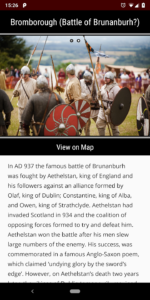
Did you know you know traces of Merseyside’s Viking settlement could be right on your doorstep?
A new project called ‘The Viking Age in the North West’ is an app which allows the general public to discover a range of different historical sites in the North West.
The project is led by Dr Clare Downham, a medieval historian at the University of Liverpool.
Clare said: “What it consists of is a map with the sites plotted, there’s about 80 of them. The project began in Merseyside, so in Liverpool and the Wirral that’s where the densest amount is on the map. A couple of years ago we extended it to the Cumbrian coast as well.”
The app is designed to shed a light on the settlement and history of Vikings in the area.
Clare explained: “What it’s really looking at is the impact the Vikings have had in the North West and particularly in Merseyside, that was where my interest began. So there’s a map and an index which goes from A-Z.
“The entries could include a range of things – for some of them, it’s where there’s been a Viking burial or some coins have been discovered, or there’s a bit of 10th century sculpture from the Viking age.”
There is also information into various place names which are derived from the Viking era, such as Toxteth’s original name meaning “the stockaded place of someone called Toxi”,an old Norse name. That shows that there was Viking settlement in the area.
Other areas such as Croxteth, Aigburth and Formby also get their names from the Vikings.
Clare said: “The Vikings who settled in Liverpool and the Wirral came over from Ireland.
“They were originally from Dublin and the Viking leaders of Dublin were expelled in 902. We have written accounts of them coming over to North-West England at the time.”
There is also mention of Viking folklore that has been passed down through centuries.
Clare said: “Folklore especially in an English context is something from before my grandparents’ generation but there’s still a living folklore from Vikings in the area which is really interesting because that’s an imaginative contemporary engagement with the heritage.
“The folklore is often not factual once you dig into it, but it’s quite nice because it’s a living heritage that flourishes outside academia.”
Clare explained that Wirral is one of the areas with especially rich Viking folklore.
“At Leasowe Castle there was a chair set up as a view point, like a park bench to look out to the sea.
“But there was an inscription on the park bench and it was a quote from a 12th century text and the quote is about King Cnut, who was a king in the 11th century who thought he was so powerful he could tell the waves not to come in and could turn the tide.
“He gets his feet wet – and this is where people’s perception of greatness is brought to a bit more of a reality check. But because the inscription was on this bench, people thought this was the chair that Cnut sat on, and then that became part of a local story and people believed it.”

There was a range of reasons behind Clare’s inspiration to create the app.
a 10th century Viking sword was found over there
She said: “The thing I find quite interesting about history is that you could walk through a place every day and there’s so many parallel universes of where that place has been and the history and what’s been happening there.
“So I think sometimes people can live in an area and not realise, ‘Oh, did you know a 10th century Viking sword was found over there?’.”
The app is also of benefit to heritage tourism
Clare explained: “If people are into Vikings, then they could if they wanted to make a costal trip to those sites which brings people into those places.
“There’s also pride of place for people to find out about the history and heritage of their own area because I think pride of place is an important part of self- identity.”
She added: “I also think well we do have standing heritage, some of these sites are in churches in Liverpool, it gives people a desire to protect those sites from development and prevents destruction and keeping local heritage preserved as well.”
She hopes that this project will get people interested in the area’s history.
“I hope it will just encourage people to get interested in their heritage in the past, it’s part of the culture of where you live and it’s good to feel invested in that, it’s good to take pride in that.
“Hopefully it will encourage people to visit these areas.”
Listen to Tara Moyes’s audio report below:










